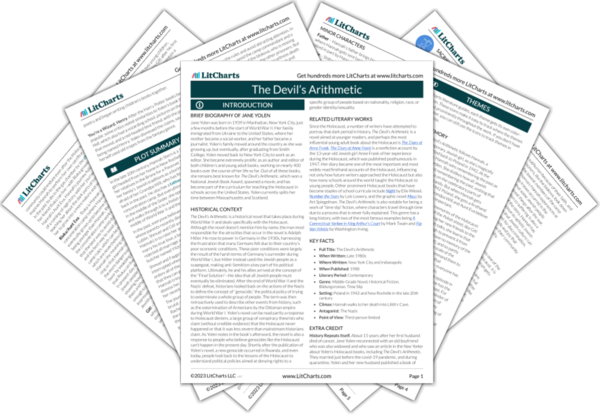The Devil’s Arithmetic begins with Hannah feeling reluctant about embracing her Jewish identity but ends with her understanding why this identity is so important to the adults in her family—and to her. While Hannah initially sees her Jewish heritage as a burden, she learns that it can also have a joyous side when she gets transported back in time to a Polish shtetl and witnesses Shmuel and Fayge’s wedding. Hannah experiences the kindness of people like the motherly Gitl and the friendship of girls like Rachel, and she sees how Judaism helps bind this small community together.
Still, while Jewish culture can be joyful, it also has a strong connection to grief and loss, starting with the suffering of the Jewish people described in the Torah and continuing through the Holocaust. Hannah learns through her experiences at the concentration camp that for centuries, Jewish people have suffered simply for existing and practicing their faith. The Nazis treat Jewish prisoners as subhuman because of their faith, and even non-Jewish fellow prisoners, like the blokova, look down on the Jewish prisoners as the lowest members of the camp hierarchy. And yet, in spite of horrors Hannah experiences at the camps and all the deaths she knows occurred in the Holocaust, Hannah also knows that some Jewish people survive and go on to accomplish great things after the war, illustrating how Judaism’s connection to suffering is also a connection to survival. By the end of the story, Hannah has learned why people like Aunt Eva continue to uphold Jewish traditions: because despite all the ways that Jewish culture can seem like a burden, making people a target for discrimination, Jewish culture is ultimately a source of pride and joy that signifies how a group of people can preserve their community traditions even in the face of extreme adversity.
Jewish Culture and Identity ThemeTracker

Jewish Culture and Identity Quotes in The Devil’s Arithmetic
“I’m tired of remembering,” said Hannah to her mother as she climbed into the car.
There was a lipstick stain where Aunt Eva had kissed her on the forehead. She ran some water and tried to scrub it off, feeling guilty because Aunt Eva was her favorite aunt, the only one who preferred her over Aaron. Hannah was even named after some friend of Aunt Eva’s. Some dead friend.
“Give them this!” Grandpa Will shouted at the TV, holding up his left arm to the set. The sleeve of his shirt was rolled up above the elbow.
Rosemary gets to eat jellybeans, and I get to eat horseradish.
“Never mind, little Chaya, never mind,” Gitl said. “Shmuel and I—we are your family now.”
Photographs of Grandma’s family but none of Grandpa Will’s, because, Aunt Eva had once explained, no photographs had been saved in the death camps. “We are our own photos. Those pictures are engraved only in our memories. When we are gone, they are gone.”
Pretty girl, with faraway eyes,
Why do you look with such surprise?
How did you get to be so wise,
Old girl in young-girl disguise.
Was knowing—or not knowing—more frightening? She couldn’t decide. A strange awful taste rose in her mouth, more bitter even than the Seder’s bitter herbs. And they were for remembering.
“Of course, Jew,” came the officer’s voice. “And then my men will move among you and take your papers and jewelry for safekeeping.”
“You are zugangi, newcomers, the lowest of the low,” the tall, dark-haired woman said to them as they huddled in the stark barracks room. She was in a blue dress with green piping and the short sleeves displayed a long number tattooed on her arm.
“God made the Devil, so God is here, too,” Rivka said.
“Organize,” Rivka said. “As I have organized some shoes for you, and not wooden clogs, either. And sweaters. You will need them because the nights are cold still.”
Part of her revolted against the insanity of the rules. Part of her was grateful. In a world of chaos, any guidelines helped. And she knew that each day she remained alive, she remained alive. One plus one plus one. The Devil’s arithmetic, Gitl called it.
The commandant stood up and stared at her, his eyes gray and unreadable. “Are you his sister?”
She shook her head dumbly, afraid to say more.
“That is good. For you.”
“If something happens to us, you must remember. Promise me, Chaya, you will remember.”
Hannah’s lips moved but no sound came out.
“Promise.”
“I will remember.” The words forced themselves out through her stiffened lips.
When it was silent at last, the commandant threw the shoes on top of Fayge’s body. “Let them all go up the stack,” he said. “Call the Kommandos. Schnell!”
The memories of Lublin and the shtetl and the camp itself suddenly seemed like the dreams. She lived, had lived, would live in the future—she, or someone with whom she shared memories. But Rivka had only now.
Then all three of them took deep, ragged breaths and walked in through the door into endless night.
“In my village, in the camp . . . in the past,” Eva said, “I was called Rivka.”
Hannah nodded and took her aunt’s fingers from her lips. She said, in a voice much louder than she had intended, so loud that the entire table hushed at its sound, “I remember. Oh, I remember.”
It later became an adoption agency, the finest in the Mideast. She called it after her young niece, who had died a hero in the camps: CHAYA.
Life.











